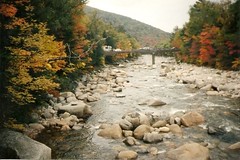Everywhere I go I am starting to see more and more uses of QR codes. I have even started incorporating them into my own materials for both the web and printed publicity.
This post will attempt to give you some brief information about what they are and some ideas on how you can use them.
QR stands for Quick Response Codes. For those of us who are a bit techie, we remember them as the old 2D Bar codes (2 dimensional) that never really took off! Most people are used to the flat single line bar codes that you see everywhere from grocery stores to product labels. Bar codes are a great way to encode a lot of data into a compressed space that is read with a bar code reader or scanner.
 A flat bar code, such as this one, does not use data compression, therefore the amount of information that can be encoded is limited. When scanned, the code is read in a linear fashion, putting all the decoded lines together to create a code. Bar codes follow industry standards based on the application of the bar code; in grocery stores the standard is UPC, in my industry we use a language called codabar or ISBT 128. The standards are usually developed by working groups and help the developers of software applications know where the bar code should be used and how to decode it.
A flat bar code, such as this one, does not use data compression, therefore the amount of information that can be encoded is limited. When scanned, the code is read in a linear fashion, putting all the decoded lines together to create a code. Bar codes follow industry standards based on the application of the bar code; in grocery stores the standard is UPC, in my industry we use a language called codabar or ISBT 128. The standards are usually developed by working groups and help the developers of software applications know where the bar code should be used and how to decode it.
ANATOMY OF A BAR CODE
Bar codes often have what are called stop and start characters. That is the first dark line of the code is the start character, the last line is the stop character. It tells the bar code reader where the code starts and what ‘language’ the rest of the bar code is in. The standards tell the decoder what kind of barcode is it; in other words, on a bag of blood, we have barcodes for the unit number, the product code, the ABO Rh and the expiration date. When the scanner reads those codes, the start character tells it which of those codes it is (<= may be the product, => may be the ABO Rh and so on…). The developer of the software that is going to use those codes know that if it is a product code, they should receive the <= as the first character of the code. The maker of the bar code scanners or readers also knows the industry standards, because the reader also uses software to recognize the types of codes it is going to read. We normally program the scanners for what ‘languages’ they are going to read. Grocery stores program their scanners to read UPC, the blood industry programs ours to read ISBT. Different standards for different applications.
So why the black and white lines? White space is called the ‘quiet zone’ black lines are the read zones or noise. Bar code scanners need quiet space and noise to know where a signal starts and stop. The quality of those black and white zones determine a quality bar code, which is why sometimes you have problems reading bar codes. Those black and white lines are called machine readable, and you will often see numbers or characters below the code which is called the ‘eye readable’ translation of the bar code. Most standards require both machine and eye readable formats so that if the scan of the bar code fails, there is still a way to know what the code says.
The stop character of the bar code tells the reader to stop reading. Sometimes there are check sum digits used in the bar code language but that starts getting into techie geeky stuff so I think we can stop with bar code theory 101 here. You can also see that because it takes so much space to produce one of these, the amount of data you can put in these codes is not practical for all applications, but works well when you want to read one discrete piece of information at a time. These bar codes also have to be printed on good quality printers so the quiet and noise spaces are distinct. Ink jet printers are not good for printing these bar codes because with ink jet printers, the ink actually sprays so ink can get in the quiet zones, and you can get breaks in the black lines.
QR CODES
 A 2D or what is now known as a QR code is better than a flat bar code because you can compress more data into a smaller space, so the world of applications for bar codes starts to open up here. The bar code is not flat but is actually 2 dimensional. The depth of that bar code is what allows us to compress more data into the code. You will also notice these do not need as much quiet and noise zones. These bar codes can store up to 4296 characters, and again they do follow a standard (ISO 18004). There are lots of other bar codes types but I think we’ve covered enough theory for this post!
A 2D or what is now known as a QR code is better than a flat bar code because you can compress more data into a smaller space, so the world of applications for bar codes starts to open up here. The bar code is not flat but is actually 2 dimensional. The depth of that bar code is what allows us to compress more data into the code. You will also notice these do not need as much quiet and noise zones. These bar codes can store up to 4296 characters, and again they do follow a standard (ISO 18004). There are lots of other bar codes types but I think we’ve covered enough theory for this post!
WHY SHOULD YOU BE USING THEM?
Because they are cool! No, they are way cool, but in reality they are a quick way to give information, links, applications to smart phone, device users! Take a look around you when you are out…how many people do you see carrying a smart phone device of some sort. Now how can YOU be getting information into their hands very quickly and easily? Enter the QR code. All you need is a bar code reader installed on your smart phone and you are on your way to reading QR Code (oh yes, that’s the other benefit of QR codes, any standard bar code reader can read them; no programming on the part of the end-user). Remember our job in providing information to end users, readers etc is to make it easily available. You don’t want your reader to have to work to get at your information!
QR Codes are intended to be used on mobile web sites. You would not want to direct a mobile users to a full version web site as they just don’t read well on small devices. So your first job, before you ever use these codes, is to make sure your web site(or wherever you are sending them when the bar codes is read) is optimized for mobile devices.
QR CODE USES
Imagine never having to type a long .url again. For those of us with touch screen displays, I can’t tell you how many times I’ve started typing an address and had to start over because I fat fingered a key (or keys). QR codes are PERFECT for .url addresses. Perhaps you want to give product information to customers on the go. They can scan the code and save the web page to read later.
Perhaps you want your customers to take a survey. On your printed material, you can remind them to take the survey and give the QR code to bring them to the survey page on their device. You are pretty much only limited by your imagination.
I have seen these codes used on a full version web site to gain access to a smart phone application. You scan the code with your phone, the .url comes up on the phone, you ‘click’ it and the app can download on the phone. Sure makes getting those special apps quick and easy and I am more likely to download them since it is right there and very easy.
I do my QR codes where I am generating a .php (web) file, opening it in a photo editor and saving the file as a .jpg. Once I have a .jpg image I can use the picture in and on any material I want, web sites, printed posters, even T-Shirts! I wanted to make it very easy for you to create these so I found a new site where you can generate all kinds of QR codes! Visit http://www.qrstuff.com/ (yes I could have put a QR code here but remember it would have brought you to the web site on your phone and you want to make these on your desktop machine or laptop).
HOW TO
This is the screen you will see:
- On the left select the type of code you want to generate.
- Based on the option you choose you will get new options in the content column as text, VCard info, .urls etc
- Pick a color you want to use for the foreground color
The code is generated as you enter the information and is ready for download. Select the download image. Based on what you selected the image is downloaded to the desktop downloads file as a .png file, which is an image file.
TIPS:
Always test scan your generated bar code to make sure it is giving you the information you want to present before you place it in printed material.
When you place the bar code where you want to use it, make sure there is a small border of white space around the entire code. It makes the reading cleaner for the scanner so there are no interfering or stray lines that could get caught in the read.
Do not make the codes too small. You will notice the reader has to focus in on the small squares around the border of the code. The smaller you make it, the denser the code becomes, the harder the read is. In most of my material I use a size f 150X150 or 200X200.
Bar Code Scanner for Smart Phone: I have a DROID Incredible and I use an application called Bar Code Scanner. No special scanners required just anything that reads bar codes! That is the beauty of QR Codes!
 If you have any questions on this you can contact me via email (scan the code) .
If you have any questions on this you can contact me via email (scan the code) .
Leave me a comment on how you plan to use these codes! I am sure my readers would love more ideas on using these codes!
~Kathie











